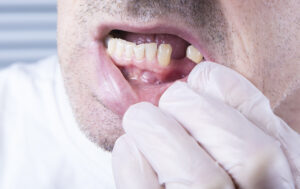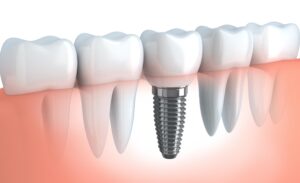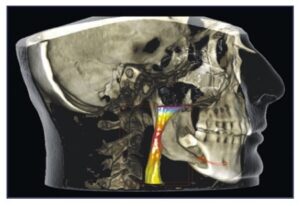Header logo
header top contact widget
gingivitis
The Mirror Image Of Dental Implants
Posted on Sep 16, 2024 by William J. Claiborne, DDS MS
A study conducted in the United Kingdom in 2015 revealed that men check out their reflection 23 times a day while women do about 16 times. While other studies dispute the gender disparity (such as women using the mirror 34 times a day on average), all adults use the mirror more often than is probably perceived.
https://www.reuters.com/article/world/us/women-seen-checking-mirror-every-half-hour-idUSL05402197/
Naturally, part of that time in the mirror is spent each morning or evening as people prepare for the day and then get ready for bed. Ideally, several minutes of this time is being devoted to brushing and flossing. But, are they really getting a good look inside their mouths?
Typically, people don’t think all that often about the presence of their teeth, unless something hurts. Certainly, when hot or cold causes a sharp “jolt” of pain or a constant ache occurs around a particular tooth, an individual realizes something needs attention. After all, there is rarely pain in the mouth that is going to repair on its own. And, pain is our brain’s way of getting our immediate attention that something is wrong.
Adult tooth loss is fairly common in the U.S. Accidents, tooth (or tooth root) fractures, decay and certain health conditions can increase one’s potential for losing natural teeth. However, periodontal (gum) disease is the most common.
It is estimated that nearly half of the adult population have some form of periodontal disease (47.3%). Symptoms may include:
• tender and swollen gums that bleed easily when brushing
• persistent bad breath
• gums that are red in color rather than a healthy pink
• gums that recede from the base of teeth
• pus pockets around teeth as bacterial accumulate
• gums that are a spongy texture
• teeth that shift or loosen
According to the Centers for Disease Control & Prevention (CDC), over one-fourth (26%) of American adults ages 65 and older have 8 or less natural teeth. The CDC equates this number (having 8 or fewer teeth) as “severe tooth loss” since it impacts an individual’s ability to thoroughly eat a healthy diet.
 While losing a tooth during a lifetime seems “normal,” any loss of an adult tooth should be a wake-up call. As an Asheville periodontist, I know that losing a natural tooth can set into motion a snowball effect. And, it’s what occurs below the gums that creates the path that, for many older adults, leads to dentures.
While losing a tooth during a lifetime seems “normal,” any loss of an adult tooth should be a wake-up call. As an Asheville periodontist, I know that losing a natural tooth can set into motion a snowball effect. And, it’s what occurs below the gums that creates the path that, for many older adults, leads to dentures.
The absence of a tooth root in the upper or lower jaw bone is a loss of stimulation to the bone mass where it was once positioned. These roots provide both stimulation and nourishment that enables the bone to maintain a healthy mass. Without the presence of tooth roots, the bone begins to “melt away” in a process known as resorption.
It is commonly known that muscles, not used, will shrink in mass. When the jaw bones are lacking stimulation by the tooth roots they’re designed to hold, bone mass begins to shrink.
Resorption begins shortly after the tooth’s root is removed. Once it starts, it continues at an ever-increasing pace. For example, the first year after a tooth root is missing, bone decline may be minimal. With each passing year, however, the pace of bone loss accelerates.
As the bone shrinks in height, natural tooth roots adjacent to the area of missing teeth are subject to movement and root damage. On average, the next teeth you’re most likely to lose are the ones bordering areas of missing teeth.
How do you halt the process of tooth loss due to bone resorption?
Because dental implants replace the tooth above the gum line AND the root portion below it, the bone is able to retain its mass. Using the sturdy foundation of the jaw bone, dental implants are able to restore the look, feel and chewing stability like that of natural teeth.
A periodontist has advanced training to properly diagnose and treat all stages of periodontal (gum) disease (including gingivitis and periodontitis) as well as placement of dental implants. Because we understand the issues that occur above and below the gums, we are proponents of replacing teeth with dental implants, for a wide number of reasons.
1. Dental implants help to prevent declining mass of the jaw bone. In addition to problems associated with dental prosthetics (dentures, partials) when it comes to biting and chewing, bone loss causes changes in facial appearance that are aging far beyond one’s actual years. An implant restores stimulation to the bone and halts the progress of bone loss.
2. Dental implants have one of the highest success rates of any in-bone implant in the body, including hips and knees. When properly selected, placed and maintained, they are designed to last your lifetime.
3. Unlike crown-&-bridge combinations or partials, dental implants do not rely on neighboring teeth for support by adjacent teeth. And, because they help to preserve the bone that supports neighboring teeth, they are actually beneficial to the life of other natural teeth.
4. Dental implants are a one-time expense. They do not decay, require root canals, crack or break, future expense for upkeep or repairs is not needed. The material they are made of (titanium) biologically integrates with living bone and is not rejected nor will it cause adverse reactions to surrounding structures. With proper care, they will last throughout your life.
5. Because dental implants are supported by the upper or lower jaw bone, just as natural tooth roots, they are able to restore biting strength and chewing stability. After an implant is placed in the bone, the bone grows around it to fully secure it in the jaw. This enables confident biting and chewing without fear of movement that is possible with a denture or partial.
Like anything that is implanted into your body, dental implants should be placed in the hands of an experienced specialist. Ideal diagnosis is important, and can even save the patient in overall treatment costs. For example, when missing more than one tooth in one area, one implant can often hold two or a bridge of teeth. Several strategically-placed implants may also be used to support a full arch of teeth.
Proper placement and support in caring for implants is an important part of a successful outcome. However, dental implants can fail. A periodontal specialist can be an asset to your investment. When dental implants are chosen and placed by a periodontist, he or she is trained to select the one that will work best for you now and throughout your lifetime.
In addition to our specialized skills, our Asheville periodontal dental office provides advanced technology and a compassionate approach to care so you can enjoy a comfortable, efficient experience that allows you to have optimal success. Some of this technology is specific to dental implants, including:
• LANAP With PerioLase MVP 7 – Laser-Assisted New Attachment Procedure is an advanced protocol that efficiently and effectively treats advanced gum disease with the added advantages of a dental laser. For patients who are preparing for dental implant placement, resolving gum disease prior to treatment is mandatory. LANAP offers a non-surgical alternative for patients with moderate to severe periodontal disease with very little discomfort and a quick recovery time.
• Cone Beam Imaging – These provide 3D images that are ideal for diagnosing and treatment planning. The highly-detailed images show sagittal, axial, and coronal planes, which locates and tracks nerve canals to optimize implant placement.
• Computerized Dental Implant Placement – This system provides the futuristic ability to position dental implants before the process actually begins. Through computerized technology, the implants are selected and “ideally positioned” on a 3D model of the patient’s jaw. From this, a template is developed for optimal treatment success, even for complex cases.
• CS 3600 Intraoral Scanner – Rather than make impressions with bulky, goopy trays, this scanner quickly and comfortably captures digital impressions accurately and easily. These are used to create precision models or appliances (dental implant crowns, bridges, or full arches). The scanner can also reach hard–to–access areas in the patient’s mouth for superior results with improved patient comfort.
For individuals who have lost teeth because dental fear or anxiety kept them from receiving regular dental care, we are especially sensitive to the concerns of these patients. Our entire team is committed to optimal patient comfort at every visit. Additionally, we offer:
• Oral sedation is a pill that helps patients relax. It also has an amnesiac effect, leaving most with little or no memory of treatment afterward.
• I.V. sedation (also known as “twilight sleep”) places the patient in a deeper sleep state and erases memory of the procedure. It is administered by a Medical Doctor (MD) who is a board certified Anesthesiologist.
For those who feel dental implants are out of reach financially, we encourage them to have a consultation to see exactly what their options may be and the treatment fees entailed. We offer several excellent payment plans, some with no down payment and no interest charged when paid according to the terms.
If you are considering dental implants, you may wish to begin with a consultation appointment. During this time, we can explain the vast difference in comfort, treatment time, and success available through our specialized skills and extensive technology.
Call 828-274-9440 to schedule. New patients are always welcome and a referral is not always required.
Recent Posts
Categories
Archives
- September 2024
- August 2024
- July 2024
- June 2024
- May 2024
- April 2024
- March 2024
- February 2024
- January 2024
- December 2023
- November 2023
- October 2023
- September 2023
- August 2023
- July 2023
- June 2023
- May 2023
- April 2023
- March 2023
- February 2023
- January 2023
- December 2022
- November 2022
- October 2022
- September 2022
- August 2022
- July 2022
- June 2022
- May 2022
- April 2022
- March 2022
- February 2022
- January 2022
- December 2021
- November 2021
- October 2021
- September 2021
- August 2021
- July 2021
- June 2021
- May 2021
- April 2021
- March 2021
- February 2021
- January 2021
- December 2020
- November 2020
- October 2020
- September 2020
- August 2020
- July 2020
- June 2020
- May 2020
- April 2020
- March 2020
- February 2020
- January 2020
- December 2019
- November 2019
- October 2019
- September 2019
- August 2019
- July 2019
- June 2019
- May 2019
- April 2019
- March 2019
- February 2019
- January 2019
- December 2018
- November 2018
- October 2018
- September 2018
- August 2018
- July 2018
- June 2018
- May 2018
- April 2018
- March 2018
- February 2018
- January 2018
- December 2017
- November 2017
- October 2017
- September 2017
- August 2017
- July 2017
- June 2017
- May 2017
- April 2017
- March 2017
- February 2017
- January 2017
- December 2016
- November 2016
- October 2016
- September 2016
- August 2016
- July 2016
- June 2016
- May 2016
- April 2016
- March 2016
- February 2016
- January 2016
- December 2015
- November 2015
- October 2015
- September 2015
- August 2015
- July 2015
- June 2015
- May 2015
- April 2015
- March 2015
- February 2015
- January 2015
- December 2014
- November 2014
- October 2014
- September 2014
- August 2014
- July 2014
- June 2014
- May 2014
- April 2014
- March 2014
- February 2014
- January 2014
- December 2013
- November 2013
- October 2013
- September 2013
- August 2013
- July 2013
- June 2013
- May 2013
- April 2013
- March 2013
- February 2013
- January 2013
- December 2012
- November 2012
- October 2012
- September 2012
- August 2012
- July 2012
- June 2012


